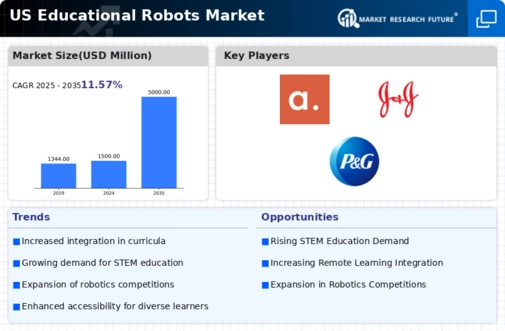Increased Investment in STEM Education
The educational robots market is experiencing a surge in investment aimed at enhancing STEM (Science, Technology, Engineering, and Mathematics) education. This trend is driven by the recognition of the importance of equipping students with essential skills for the future workforce. In the US, funding for educational robotics programs has increased, with schools and districts allocating budgets to integrate robotics into their curricula. Reports indicate that educational institutions are expected to invest over $1 billion in robotics education by 2026. This influx of capital not only supports the purchase of educational robots but also facilitates teacher training and curriculum development, thereby fostering a more engaging learning environment. As a result, the educational robots market is likely to expand, driven by the growing emphasis on STEM education and the need for innovative teaching tools.
Advancements in Artificial Intelligence
The educational robots market is significantly influenced by advancements in artificial intelligence (AI), which enhance the capabilities of educational robots. AI technologies enable robots to interact more effectively with students, providing real-time feedback and adapting to their learning pace. In the US, the integration of AI in educational tools is expected to reach a market value of $2 billion by 2025. This technological evolution not only improves the functionality of educational robots but also makes them more appealing to educators and students alike. As AI continues to evolve, the educational robots market is likely to see an increase in demand for robots that can facilitate interactive and immersive learning experiences. The potential for AI-driven educational robots to transform traditional teaching methods suggests a promising future for this segment of the market.
Growing Emphasis on Coding and Robotics Skills
The educational robots market is benefiting from a growing emphasis on coding and robotics skills within the US education system. As the job market increasingly demands proficiency in technology and programming, schools are prioritizing the teaching of these skills from an early age. Educational robots serve as effective tools for introducing students to coding concepts in a hands-on manner. Reports indicate that over 60% of US schools have incorporated coding into their curricula, with many utilizing educational robots as a means to engage students. This trend is likely to drive the educational robots market, as more institutions seek to equip students with the necessary skills for future careers in technology. The focus on coding and robotics education is expected to continue, further solidifying the role of educational robots in modern classrooms.
Rising Demand for Personalized Learning Solutions
The educational robots market is witnessing a notable shift towards personalized learning solutions, which cater to the diverse needs of students. As educators increasingly recognize that one-size-fits-all approaches are ineffective, the demand for educational robots that can adapt to individual learning styles is on the rise. These robots are designed to provide tailored feedback and support, enhancing student engagement and comprehension. In the US, the market for personalized learning technologies is projected to grow at a CAGR of 20% through 2027. This growth is indicative of a broader trend towards customization in education, where educational robots play a pivotal role in facilitating personalized learning experiences. Consequently, the educational robots market is likely to benefit from this demand, as schools seek innovative solutions to meet the unique needs of their students.
Support from Educational Policies and Initiatives
The educational robots market is positively impacted by supportive educational policies and initiatives at both state and federal levels. Policymakers are increasingly recognizing the value of integrating technology into education, leading to the development of programs that promote the use of educational robots in classrooms. In the US, initiatives such as the Every Student Succeeds Act (ESSA) encourage the adoption of innovative teaching methods, including robotics. Funding opportunities and grants are being made available to schools that implement robotics programs, thereby facilitating access to educational robots. This supportive environment is likely to stimulate growth in the educational robots market, as more schools take advantage of these resources to enhance their educational offerings. The alignment of educational policies with the goals of the educational robots market suggests a favorable outlook for future expansion.













Leave a Comment